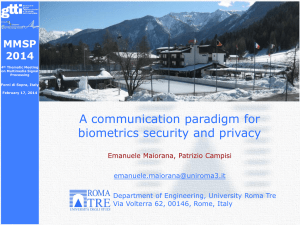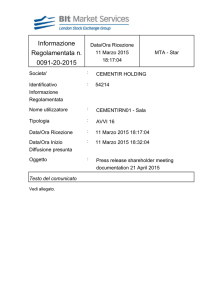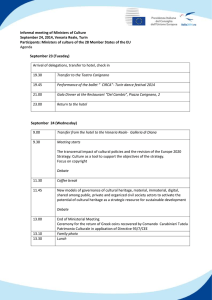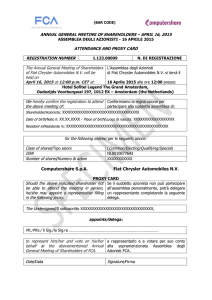Transportation-theoretic image counterforensics to
advertisement
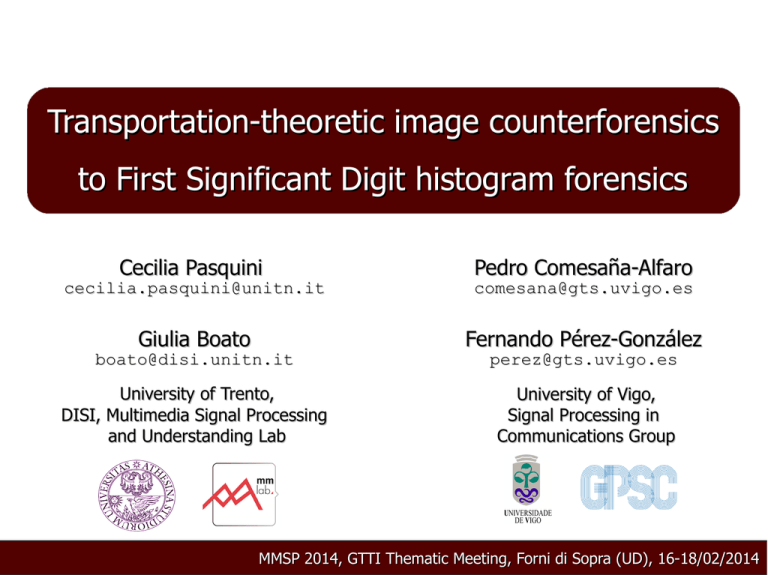
Transportation-theoretic image counterforensics to First Significant Digit histogram forensics Cecilia Pasquini Pedro Comesaña-Alfaro cecilia.pasquini@unitn.it comesana@gts.uvigo.es Giulia Boato Fernando Pérez-González University of Trento, DISI, Multimedia Signal Processing and Understanding Lab University of Vigo, Signal Processing in Communications Group boato@disi.unitn.it perez@gts.uvigo.es MMSP 2014, GTTI Thematic Meeting, Forni di Sopra (UD), 16-18/02/2014 Motivation Multimedia forensic scenario Manipulation Forensic analysis ed Tamper Adversarial environment Manipulation Counterforensics action Forensic analysis tic n e h t u A MMSP 2014, GTTI Thematic Meeting, Forni di Sopra (UD), 16-18/02/2014 Adversarial signal processing Study of general theoretic solutions to problems involving an attacker and a defender [Barni and Pérez-González, 2013] For the case of multimedia forensics, tradeoff between the fidelity of the statistics recovered and the distortion introduced in the object [Kirchner and Boehme, 2013] Analysis of the optimal strategy for one or both players under specific hypothesis [Barni and Tondi, 2013] [Barni et al., 2012] [Comesaña-Alfaro and Pérez-González, 2013] MMSP 2014, GTTI Thematic Meeting, Forni di Sopra (UD), 16-18/02/2014 First Significant Digits in JPEG image forensics ... Number of compressions 0 1 Detectors discriminating single, double or multiple compressed images using FSD probabilities as features [Li et al., 2008] [Milani et al., 2012] GENERAL PROBLEM: n compressions FSD histogram 2 n Attacks modifying the distribution of FSDs in order to mislead the forensic analysis [Milani et al., 2013] [Pasquini and Boato, 2013] m compressions FSD histogram Is there an optimal strategy for a generic detector? MMSP 2014, GTTI Thematic Meeting, Forni di Sopra (UD), 16-18/02/2014 Outline Transportation-theoretic formulation of the problem as a two-step optimization process Design of a novel technique providing an approximated solution of the optimization problem for a class of distortion measures (including the MSE) Analysis of the distortion introduced on a dataset of images and comparison with state-of-the-art method MMSP 2014, GTTI Thematic Meeting, Forni di Sopra (UD), 16-18/02/2014 Basic definitions Pixel DCT FSD FSD histogram Bijective orthonormal transformation EX: distance between the DCT vectors Fixed , we define and and distance between the FSD vectors PROBLEM: given a starting DCT vector such that its FSD histogram is equal to and and a target histogram , modify minimizing the distortion: MMSP 2014, GTTI Thematic Meeting, Forni di Sopra (UD), 16-18/02/2014 Transportation-theoretic formulation The problem can be formulated as a two-step optimization process: Computationally unfeasible! DCT VECTORS FSD VECTORS FSD HISTOGRAMS MMSP 2014, GTTI Thematic Meeting, Forni di Sopra (UD), 16-18/02/2014 Approximated optimization technique I Assumption: Given the subset so that each NOVEL PROCEDURE: where is a symmetric convex function depending on the difference between its input arguments (it holds for any metrics induced by a norm, like the MSE). to which we can move the initial values, we define is minimized. EX: integer numbers, a new DCT vector is determined starting from a given input vector and a target histogram for every component of in descending order of magnitude, a new FSD is chosen by means of the map MMSP 2014, GTTI Thematic Meeting, Forni di Sopra (UD), 16-18/02/2014 Approximated optimization technique II set of digits with histogram is sorted in descending order ITERATIVE PROCEDURE For EX: Minimization of Definition of Extraction from the set of the digit obtained end After a reordering operation, is obtained as approximated solution instead of the exact one MMSP 2014, GTTI Thematic Meeting, Forni di Sopra (UD), 16-18/02/2014 Experimental setting Three different binary hypothesis testing problems: H0: 0 compressions H1: 1 compression H0: 0 compressions H1: 2 compressions H0: 1 compression H1: 2 compressions where different quality factors have been considered. UCID dataset: 600 images for creating the reference target histograms (by means of an averaging operation), 738 images for the testing phase; Comparison with a state-of-the-art method based on waterfilling techniques in terms of mean MSE (converted to PSNR) over the testing set [Milani et al., 2013] MMSP 2014, GTTI Thematic Meeting, Forni di Sopra (UD), 16-18/02/2014 Experimental results 1→0 2→0 2→1 QF1 50 60 70 80 90 TT 41.03 41.56 42.11 43.38 46.22 WF 34.47 34.22 34.58 34.91 43.77 QF2 50 60 70 80 90 TT 38.21 38.58 41.33 44.17 42.83 WF 33.14 33.14 34.29 35.86 35.12 QFt QF2 50 60 70 80 90 50 TT 42.71 41.37 38.49 39.20 38.61 WF 33.65 37.32 36.33 35.03 36.05 TT 42.08 42.95 41.33 39.08 40.70 WF 33.65 38.20 36.49 36.11 36.55 TT 39.23 42.25 42.98 42.16 43.57 WF 32.34 32.77 37.66 37.36 37.45 TT 36.99 38.93 41.93 44.04 43.82 WF 32.17 32.40 33.31 39.13 34.57 TT 36.17 36.73 39.22 44.16 40.85 WF 32.99 32.46 33.41 35.14 34.35 60 70 80 90 MMSP 2014, GTTI Thematic Meeting, Forni di Sopra (UD), 16-18/02/2014 Visual comparison PSNR=48.04 dB PSNR=40.29 dB Starting FSD histograms: 2 compressions (75, 90). Target FSD histograms: 1 compression (70). MMSP 2014, GTTI Thematic Meeting, Forni di Sopra (UD), 16-18/02/2014 Final discussions and future work Extension to other distortion measures based on visual perception, like WPSNR or SSIM Joint analysis with the problem of DCT histogram modification Experiments on a wider datasets composed by images of different source and size Dealing with multiple compression steps MMSP 2014, GTTI Thematic Meeting, Forni di Sopra (UD), 16-18/02/2014 Thank you! MMSP 2014, GTTI Thematic Meeting, Forni di Sopra (UD), 16-18/02/2014 References [Pasquini and Boato, 2014] C. Pasquini, P. Comesaña-Alfaro, F. Pérez-González, “Transportation-theoretic image counterforensics to first significant digit histogram forensics,” accepted to IEEE ICASSP, 2014. [Barni and Pérez-Gonzalez, 2013] M. Barni, F. Pérez-González, “Coping with the enemy: advances in adversary-aware signal processing,” in Proceedings of IEEE ICASSP, 2013. [Kirchner and Boehme, 2013] M. Kirchner, R. Boehme, “Counter-forensics: attacking image forensics,” in H.T. Sencar and N.D. Memon (eds.): Digital Image Forensics, 2013. [Barni and Tondi, 2013] M. Barni, B. Tondi, “The source identification game: an information-theoretic perspective,” IEEE Transactions on Information Forensics and Security, vol. 8, no. 3, 2013. [Barni et al., 2012] M. Barni, M. Fontani, B. Tondi, “A universal technique to hide traces of histogrambased image manipulations,” in Proceedings of ACM MM&Sec, 2012. [Comesaña and Pérez-González, 2013] P. Comesaña-Alfaro, F. Pérez-González, “Optimal counterforensics to histogram-based forensics,” in Proceedings of IEEE ICASSP, 2013. [Li et al., 2008] Li, Y.Q. Shi, J. Huang, “Detecting doubly compressed JPEG images by using mode based first digit features,” in Proceedings of IEEE MMSP, 2008. [Milani et al., 2012] S. Milani, M. Tagliasacchi, S. Tubaro, “Discriminating multiple JPEG compression using first digit features”, in Proceedings of IEEE ICASSP, 2012. [Milani et al., 2013] S. Milani, M. Tagliasacchi, S. Tubaro, “Antiforensics attacks to Benford's law for the detection of double compressed images,” in Proceedings of IEEE ICASSP, 2013. [Pasquini and Boato, 2013] C. Pasquini, G. Boato, “JPEG compression anti-forensics based on first significant digits distribution, in Proceedings of IEEE MMSP, 2013. MMSP 2014, GTTI Thematic Meeting, Forni di Sopra (UD), 16-18/02/2014
